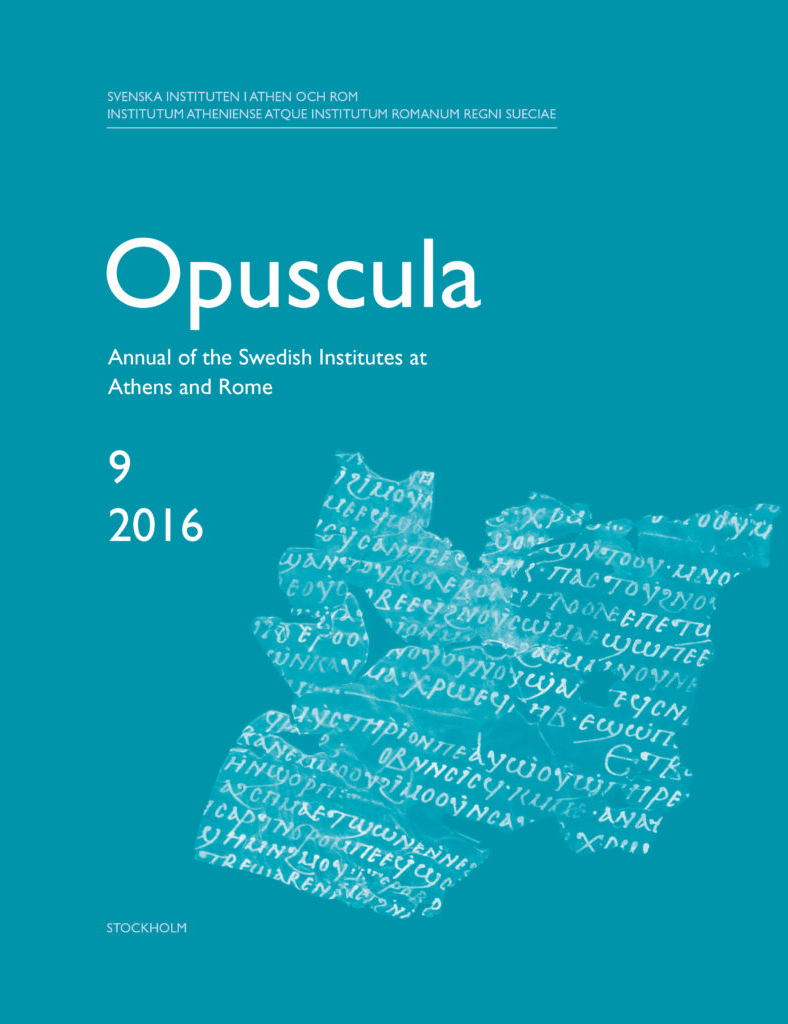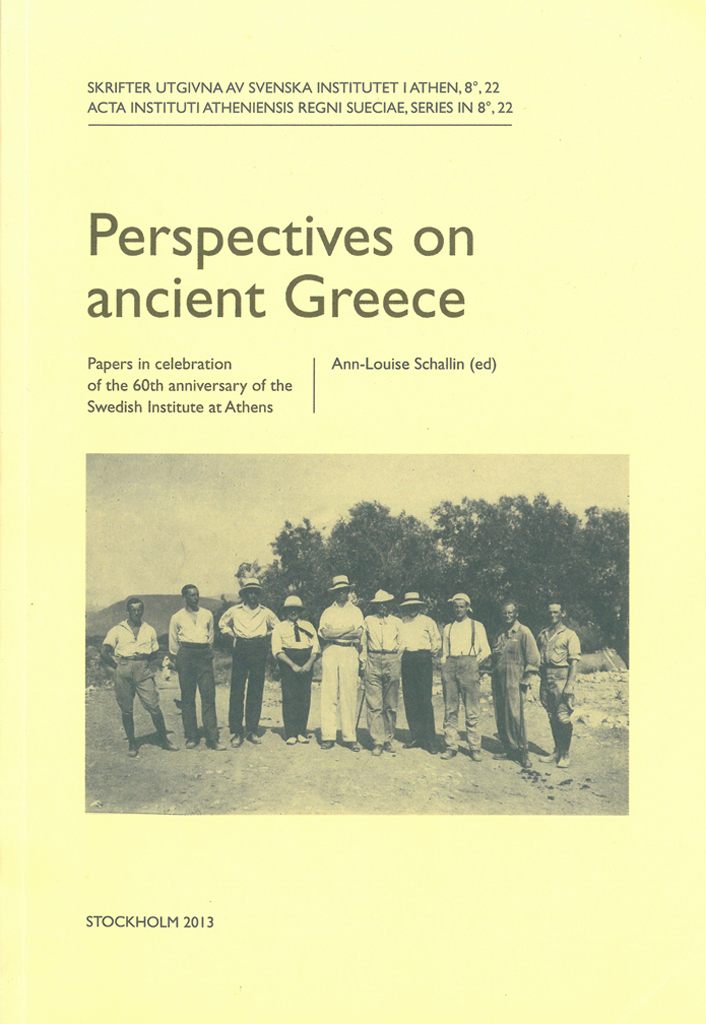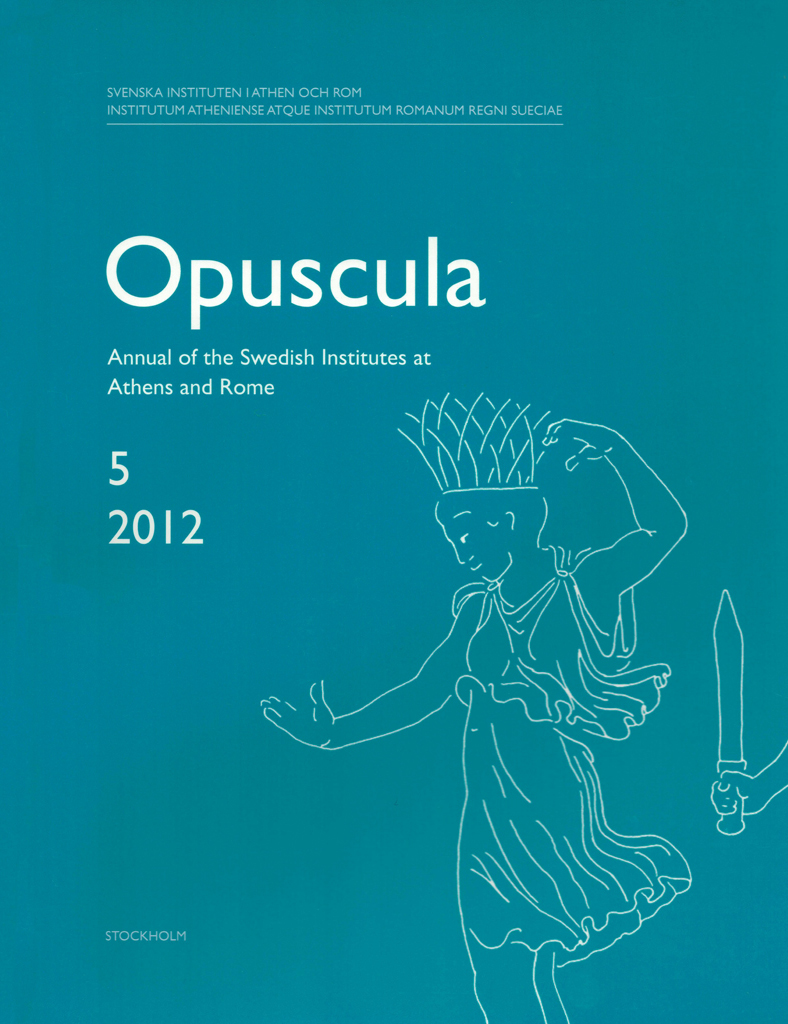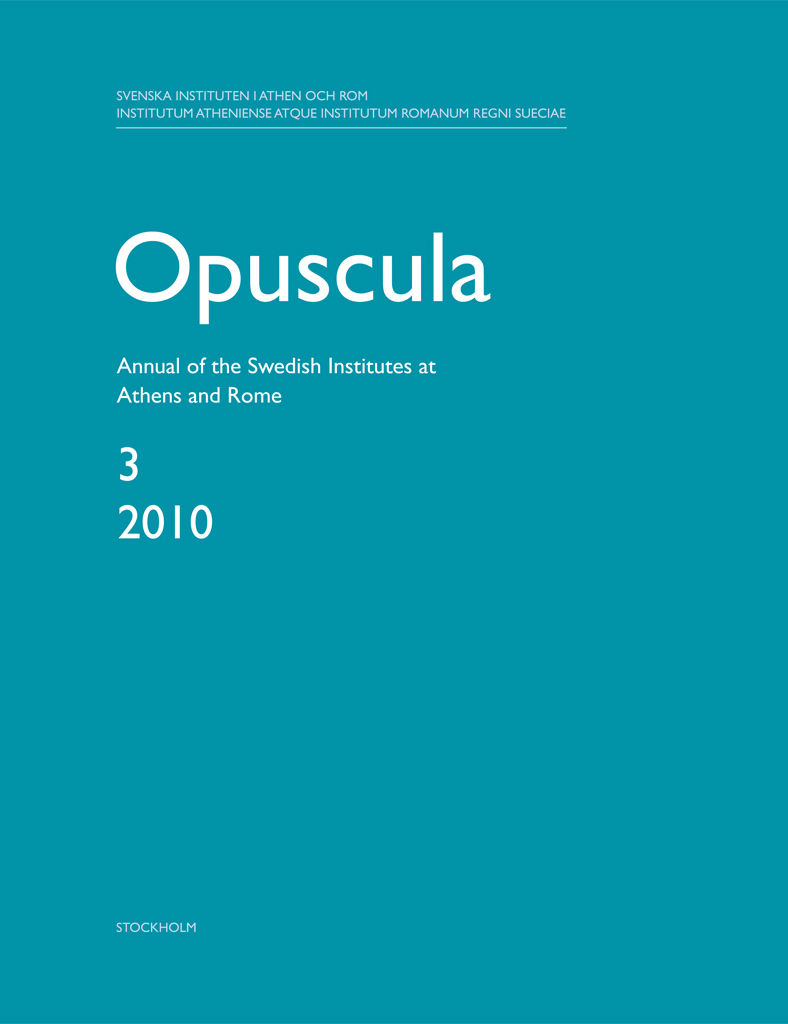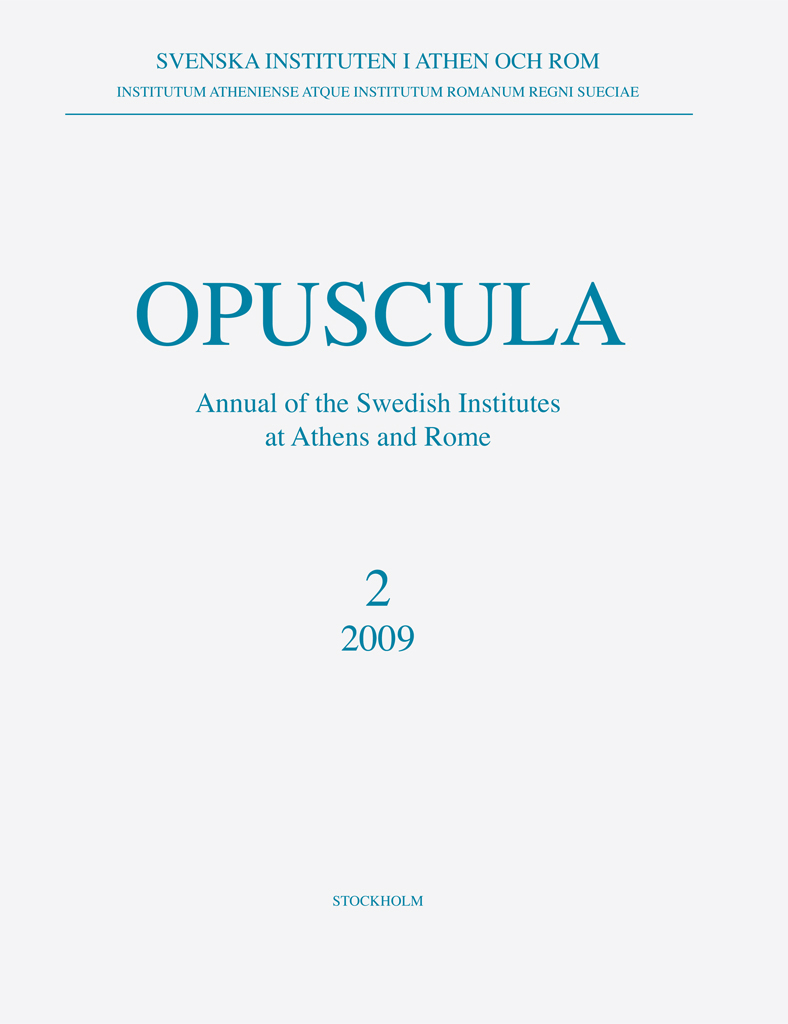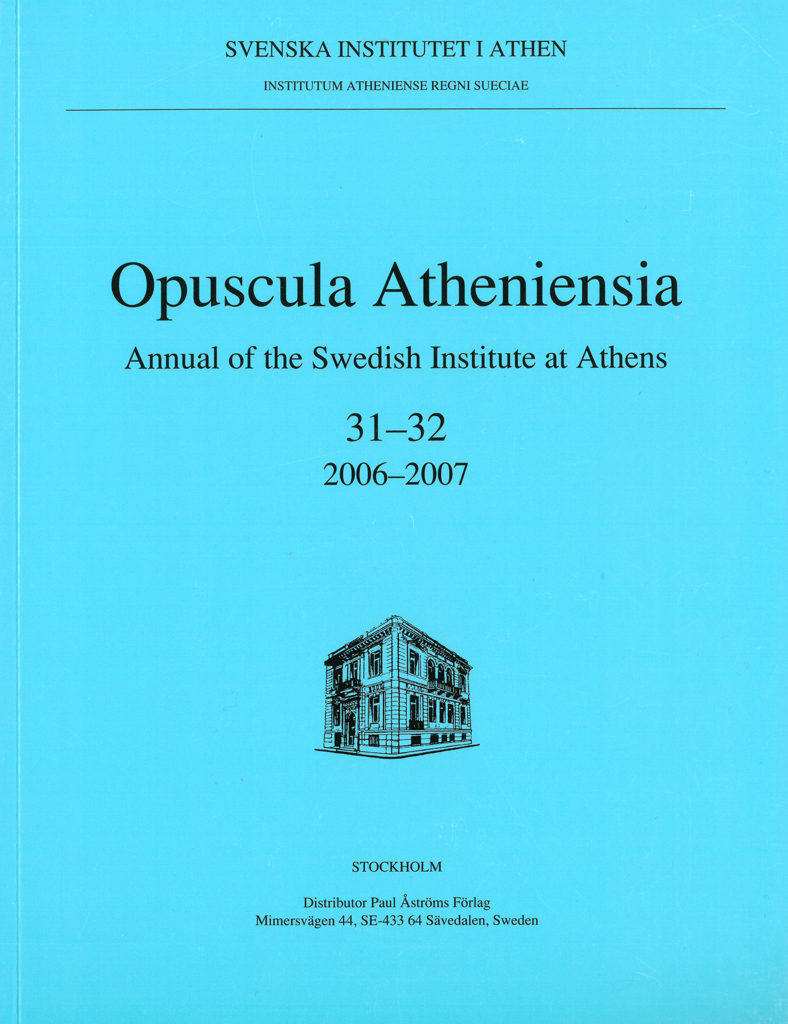Published by the Swedish Research Institute in Istanbul (SRII) and distributed by Eddy.se AB at srii.bokorder.se. Also available for purchase at Amazon.com, Bokus.com, and Adlibris.com. The Labraunda-series is edited by the Editorial Committee of the Swedish Institutes at Athens and Rome. Labraunda 5. The Andrones By Pontus Hellström and Jesper Blid Abstract This is the final publication of the two Hekatomnid Andrones at Labraunda. The older of these (the Andron of Maussollos or Andron B) was built by the satrap Maussollos (377/6–353/2 BC). This is shown by the dedicatory inscription on the architrave. The other andron (Andron A) is clearly later and was probably built by Idrieus (351/0 344/3 BC), the brother and successor of Maussollos as satrap of Karia. This building has the same kind of dedication, but the name of the commissioner is not preserved. These two buildings are unique both for their size, temple-like front, and high degree of preservation and for their Ionic-Doric mixed order, the function as banqueting halls, and the large niche at the back of the inner room. In the publication the architecture of the two buildings is systematically presented together with plans and elevations of the ruins and reconstructions. The walls are…
Opuscula is published by the Swedish Institutes at Athens and Rome, with the aid of a grant from the Swedish Research Council. Distributed by Eddy.se AB. View journal at ERIH PLUS. All content available with open access. The stadion of Labraunda By Paavo Roos Abstract The stadion of Labraunda is situated south-west of the sanctuary, above the Sacred Way down to Mylasa. As the terrain is not well suited for a stadion the ends had to be elongated by the addition of built-up ‘towers’; nevertheless the racecourse was rather short at 172 metres. It is situated on a slight slope, and in the middle of the northern side there are cuttings in the rock that may have been used for spectators; otherwise there are no provisions for such. There is a line of starting blocks at either end, more or less in their original place, although few of the blocks are exactly in situ and some of them are missing. They are large blocks and have one single continuous groove for the toes of the runner and square holes that separate the lanes. Evidently the number of lanes was 14, and each line was 1.38 m wide. There is nothing…
Opuscula is published by the Swedish Institutes at Athens and Rome, with the aid of a grant from the Swedish Research Council. Distributed by Eddy.se AB. View journal at ERIH PLUS. All content available with open access. The rock-cut chamber tombs of Labraunda By Paavo Roos Abstract The rock-cut chamber tombs form a very small percentage of the rock-cut tombs in Labraunda. The majority of these tombs, situated next to the sanctuary, were studied by Paul Åström in 1950 together with the sarcophagi; two improved from natural caves further from the sanctuary in both directions were found in a topographic survey conducted by Lars Karlsson in 2005, and finally one tomb at some distance away on the plain is also included in the article. The tombs are of various types and are probably to be dated to the Hellenistic and Roman periods. No finds have been recorded in them, either in 1950 or later. Bibliographical information Paavo Roos, ‘The rock-cut chamber tombs of Labraunda’, Opuscula. Annual of the Swedish Institutes at Athens and Rome (OpAthRom) 9, Stockholm 2016, 271–284. ISSN: 2000-0898. ISBN: 978-91-977798-8-3. https://doi.org/10.30549/opathrom-09-10
Opuscula is published by the Swedish Institutes at Athens and Rome, with the aid of a grant from the Swedish Research Council. Distributed by Eddy.se AB. View journal at ERIH PLUS. All content available with open access. Labraunda 2012-2013. A preliminary report on the work at the sanctuary. With a new reconstruction drawing of the sanctuary by Jesper Blid Kullberg and an appendix by Fredrik Tobin By Lars Karlsson, Jesper Blid Kullberg, Baptiste Vergnaud, Agneta Freccero & Fredrik Tobin Abstract This article is divided into two parts. In the first part, preliminary reports on the archaeological work conducted at the sanctuary during the years 2012 and 2013 is presented, and in the second part, two conservation projects are discussed. The first part includes a description of the excavations at the Split Rock by Lars Karlsson, an account of the excavations on the slope of the Monumental Tomb, a description of the work at the Akropolis Fortress gate by Baptiste Vergnaud, and a synopsis of the work at the M-Building. The second part starts with a report on the preparations for the stabilization of Andron A and continues with an account of the last two years of marble conservation by Agneta…
Published by the Swedish Institute at Athens. Distributed by Eddy.se AB. Perspectives on ancient Greece. Papers in celebration of the 60th anniversary of the Swedish Institute at Athens Edited by Ann-Louise Schallin Abstract This volume presents current research related to Greek prehistory and Classical Archaeology and thus serves as a crosssection of the research strategies, which the Swedish Institute at Athens promotes. The topics relate to research, which span from the Neolithic to the Hellenistic times. The reason for putting this publication together is twofold: one aim is to publish the papers, which were put forward by a select number of Swedish scholars who were invited to give lectures at the Swedish Institute at Athens during the celebrations commemorating the Institute’s 60th anniversary on 10 May 2008. The second aim is to honour professor emeritus Robin Hägg, who was the director at the Swedish Institute at Athens from 1976 to 1994. This book thus consists of articles based on the lectures, which were held at the Swedish Institute celebrations on May 10 2008 and also of a number of articles by scholars who wished to celebrate Robin Hägg and who thus joined the venture. Contents Acknowledgements Ann-Louise Schallin | Introduction…
Opuscula is published by the Swedish Institutes at Athens and Rome, with the aid of a grant from the Swedish Research Council. Distributed by Eddy.se AB. View journal at ERIH PLUS. All content available with open access. Labraunda 2011. A preliminary report on the Swedish excavations with an appendix by Ragnar Hedlund By Lars Karlsson, Jesper Blid & Olivier Henry Abstract The main goals of the 2011 campaign were the excavation of the Kepez tower, the West Church and the necropoleis. The tower of Kepez was excavated and black-gloss pottery indicates a date in the 3rd century BC. The 2011 excavations in the West Church uncovered three Late Roman and Byzantine building phases. Among the finds from Late Antiquity was a well-preserved glass lamp with a Greek inscription and a marble figurine, possibly representing an apostle or a saint. The excavations in the necropolis uncovered eleven tombs in the Area 5B, located along the Sacred Way, completing the excavation initiated in 2010. New tombs were discovered in the territory east and south of the sanctuary. Finally, the three stone sarcophagi inside the Built Tomb were moved in order to facilitate complete excavation and the cleaning of all the interior space…
Opuscula is published by the Swedish Institutes at Athens and Rome, with the aid of a grant from the Swedish Research Council. Distributed by Eddy.se AB. View journal at ERIH PLUS. All content available with open access. Labraunda 2010. A preliminary report on the Swedish excavations By Lars Karlsson, Jesper Blid & Olivier Henry Abstract The campaign of 2010 continued the work which was initiated last year. The excavations in the fortress on the Tepesar Hill were completed. The fortress consists of a large, early Hekatomnid tower where two black-gloss vessels indicated a dating of the tower to about 380–350 BC. In the two additions to the tower, several wellpreserved vessels dating from the 3rd century BC were uncovered. The latest fragment was a painted piece from a lagynos from around 200 BC, but there were no fragments of Megarian bowls. The test probe of last year in the West Church Complex was extended to a larger trench measuring c. 9 × 12 m. Evidence for three major phases could be established by J. Blid: (1) a Late Classical stoa; (2) the stoa colonnade is rebuilt into a Christian basilica of the 5th century AD; (3) a Middle Byzantine building…
Opuscula is published by the Swedish Institutes at Athens and Rome, with the aid of a grant from the Swedish Research Council. Distributed by Eddy.se AB. View journal at ERIH PLUS. Content available with open access. Labraunda 2009. A preliminary report on the Swedish excavations with contributions by Jesper Blid and Olivier Henry By Lars Karlsson Abstract The 2009 campaign in Labraunda accomplished three goals: the termination of the excavations in the Byzantine fort on the Acropolis and in the Late Roman Tetraconch and the complete excavation of the impressive marble chamber tomb along the Sacred Way. In the Acropolis Fortress, evidence was found to support the military character of the Byzantine establishment: the rooms along the fortification wall were paved and had a rectangular shape, suggesting defensive rooms. In these rooms sling stones were found. Structures dating from the Hekatomnid period were further investigated this year, and a well cut into the gneiss bedrock was excavated. In the Tetraconch, the north apse was excavated down to bedrock and a coin from Constantius II (348–357/8) suggests an ante quem dating for this unique and sophisticated structure. The geophysical investigations indicated that a church is located on the terrace below the…
Opuscula is published by the Swedish Institutes at Athens and Rome, with the aid of a grant from the Swedish Research Council. Distributed by Eddy.se AB. View journal at ERIH PLUS. All content available with open access. Labraunda 2008. A preliminary report on the Swedish excavations By Lars Karlsson, Jesper Blid & Olivier Henry Abstract The Swedish archaeological project at the Karian sanctuary of Zeus Labraundos celebrated, in 2008, sixty years of work. The year 2008 was very special, both because of these celebrations, but also because of the important finds that came to light during the excavation of the unusual Roman bath that was discovered in 2007. It is built in the shape of a four-leaf clover (the so-called Tetraconch), and can be dated to the first half of the fourth century AD. A large amount of finds were discovered, including superb pieces of plates in African Red Slip and Late Roman C wares, a water flask, and coloured marble pieces. In the necropolis, we excavated another 19 rock-cut tombs. The finds from these include a golden ring with a cornelian stone and 22 gold appliqués in the shape of rosettes and palmettes. The appliqués had four holes to…
Published by the Swedish Institute at Athens. Distributed by Eddy.se AB. Opuscula Atheniensia. Annual of the Swedish Institute at Athens 31–32, 2006–2007 Contents Katie Demakopoulou, Nicoletta Divari-Valakou, Monica Nilsson & Ann-Louise –Schallin, ‘Excavations in Midea 2005’, pp. 7–29. Berit Wells, Arto Penttinen & Jenni Hjohlman, with contributions by Kristian Göransson, Arja Karivieri & Maria Daniela Trifirò, ‘The Kalaureia Excavation Project. The 2004 and 2005 seasons’, pp. 31–129. Mats Johnson, ‘Early farming in the land of springs. Settlement patterns and agriculture in Neolithic Greece’, pp. 131–170. Mercourios Georgiadis & Chrysanthi Gallou, ‘The cemeteries of the Argolid and the south-eastern Aegean during the Mycenaean period. A landscape and waterscape assessment’, pp. 171–182. Helène Whittaker, ‘Burnt animal sacrifice in Mycenaean cult. A review of the evidence’, pp. 183–190. David S. Reese, ‘Organic imports from Late Bronze Age Cyprus (with special reference to Hala Sultan Tekke)’, pp. 191–209. Helen Mangou, Michalis Petropoulos, Alexander Gasparatos, Elias Tsakmakis & Panayiotis V. Ioannou, ‘The temple of Artemis (F)aontia, at Rakita, Achaia, Greece. Chemical compositions of metal and glass votives’, pp. 211–220. Lena Sjögren, ‘The Eteocretans. Ancient traditions and modern constructions of ethnic identity’, pp. 221–230. Jesper Blid, ‘New research on Carian Labraunda in Late Antiquity’, pp. 231–255….



